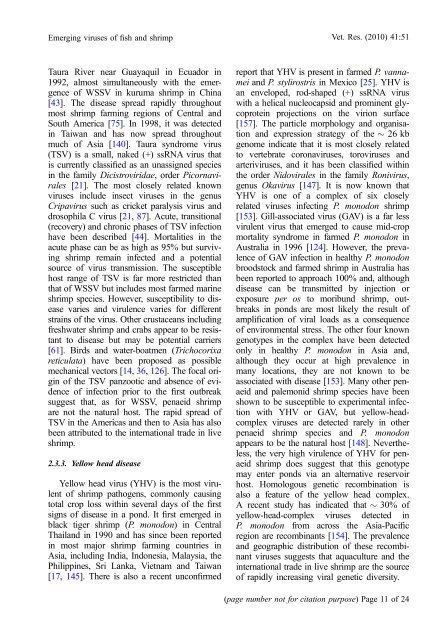Emerging viral diseases of fish and shrimp - Watershed Watch ...
Emerging viral diseases of fish and shrimp - Watershed Watch ...
Emerging viral diseases of fish and shrimp - Watershed Watch ...
Create successful ePaper yourself
Turn your PDF publications into a flip-book with our unique Google optimized e-Paper software.
<strong>Emerging</strong> viruses <strong>of</strong> <strong>fish</strong> <strong>and</strong> <strong>shrimp</strong> Vet. Res. (2010) 41:51<br />
Taura River near Guayaquil in Ecuador in<br />
1992, almost simultaneously with the emergence<br />
<strong>of</strong> WSSV in kuruma <strong>shrimp</strong> in China<br />
[43]. The disease spread rapidly throughout<br />
most <strong>shrimp</strong> farming regions <strong>of</strong> Central <strong>and</strong><br />
South America [75]. In 1998, it was detected<br />
in Taiwan <strong>and</strong> has now spread throughout<br />
much <strong>of</strong> Asia [140]. Taura syndrome virus<br />
(TSV) is a small, naked (+) ssRNA virus that<br />
is currently classified as an unassigned species<br />
in the family Dicistroviridae, orderPicorna<strong>viral</strong>es<br />
[21]. The most closely related known<br />
viruses include insect viruses in the genus<br />
Cripavirus such as cricket paralysis virus <strong>and</strong><br />
drosophila C virus [21, 87]. Acute, transitional<br />
(recovery) <strong>and</strong> chronic phases <strong>of</strong> TSV infection<br />
have been described [44]. Mortalities in the<br />
acute phase can be as high as 95% but surviving<br />
<strong>shrimp</strong> remain infected <strong>and</strong> a potential<br />
source <strong>of</strong> virus transmission. The susceptible<br />
host range <strong>of</strong> TSV is far more restricted than<br />
that <strong>of</strong> WSSV but includes most farmed marine<br />
<strong>shrimp</strong> species. However, susceptibility to disease<br />
varies <strong>and</strong> virulence varies for different<br />
strains <strong>of</strong> the virus. Other crustaceans including<br />
freshwater <strong>shrimp</strong> <strong>and</strong> crabs appear to be resistant<br />
to disease but may be potential carriers<br />
[61]. Birds <strong>and</strong> water-boatmen (Trichocorixa<br />
reticulata) have been proposed as possible<br />
mechanical vectors [14, 36, 126]. The focal origin<br />
<strong>of</strong> the TSV panzootic <strong>and</strong> absence <strong>of</strong> evidence<br />
<strong>of</strong> infection prior to the first outbreak<br />
suggest that, as for WSSV, penaeid <strong>shrimp</strong><br />
are not the natural host. The rapid spread <strong>of</strong><br />
TSV in the Americas <strong>and</strong> then to Asia has also<br />
been attributed to the international trade in live<br />
<strong>shrimp</strong>.<br />
2.3.3. Yellow head disease<br />
Yellow head virus (YHV) is the most virulent<br />
<strong>of</strong> <strong>shrimp</strong> pathogens, commonly causing<br />
total crop loss within several days <strong>of</strong> the first<br />
signs <strong>of</strong> disease in a pond. It first emerged in<br />
black tiger <strong>shrimp</strong> (P. monodon) in Central<br />
Thail<strong>and</strong> in 1990 <strong>and</strong> has since been reported<br />
in most major <strong>shrimp</strong> farming countries in<br />
Asia, including India, Indonesia, Malaysia, the<br />
Philippines, Sri Lanka, Vietnam <strong>and</strong> Taiwan<br />
[17, 145]. There is also a recent unconfirmed<br />
report that YHV is present in farmed P. vannamei<br />
<strong>and</strong> P. stylirostris in Mexico [25]. YHV is<br />
an enveloped, rod-shaped (+) ssRNA virus<br />
with a helical nucleocapsid <strong>and</strong> prominent glycoprotein<br />
projections on the virion surface<br />
[157]. The particle morphology <strong>and</strong> organisation<br />
<strong>and</strong> expression strategy <strong>of</strong> the 26 kb<br />
genome indicate that it is most closely related<br />
to vertebrate coronaviruses, toroviruses <strong>and</strong><br />
arteriviruses, <strong>and</strong> it has been classified within<br />
the order Nido<strong>viral</strong>es in the family Ronivirus,<br />
genus Okavirus [147]. It is now known that<br />
YHV is one <strong>of</strong> a complex <strong>of</strong> six closely<br />
related viruses infecting P. monodon <strong>shrimp</strong><br />
[153]. Gill-associated virus (GAV) is a far less<br />
virulent virus that emerged to cause mid-crop<br />
mortality syndrome in farmed P. monodon in<br />
Australia in 1996 [124]. However, the prevalence<br />
<strong>of</strong> GAV infection in healthy P. monodon<br />
broodstock <strong>and</strong> farmed <strong>shrimp</strong> in Australia has<br />
been reported to approach 100% <strong>and</strong>, although<br />
disease can be transmitted by injection or<br />
exposure per os to moribund <strong>shrimp</strong>, outbreaks<br />
in ponds are most likely the result <strong>of</strong><br />
amplification <strong>of</strong> <strong>viral</strong> loads as a consequence<br />
<strong>of</strong> environmental stress. The other four known<br />
genotypes in the complex have been detected<br />
only in healthy P. monodon in Asia <strong>and</strong>,<br />
although they occur at high prevalence in<br />
many locations, they are not known to be<br />
associated with disease [153]. Many other penaeid<br />
<strong>and</strong> palemonid <strong>shrimp</strong> species have been<br />
shown to be susceptible to experimental infection<br />
with YHV or GAV, but yellow-headcomplex<br />
viruses are detected rarely in other<br />
penaeid <strong>shrimp</strong> species <strong>and</strong> P. monodon<br />
appears to be the natural host [148]. Nevertheless,<br />
the very high virulence <strong>of</strong> YHV for penaeid<br />
<strong>shrimp</strong> does suggest that this genotype<br />
may enter ponds via an alternative reservoir<br />
host. Homologous genetic recombination is<br />
also a feature <strong>of</strong> the yellow head complex.<br />
A recent study has indicated that 30% <strong>of</strong><br />
yellow-head-complex viruses detected in<br />
P. monodon from across the Asia-Pacific<br />
region are recombinants [154]. The prevalence<br />
<strong>and</strong> geographic distribution <strong>of</strong> these recombinant<br />
viruses suggests that aquaculture <strong>and</strong> the<br />
international trade in live <strong>shrimp</strong> are the source<br />
<strong>of</strong> rapidly increasing <strong>viral</strong> genetic diversity.<br />
(page number not for citation purpose) Page 11 <strong>of</strong> 24
















